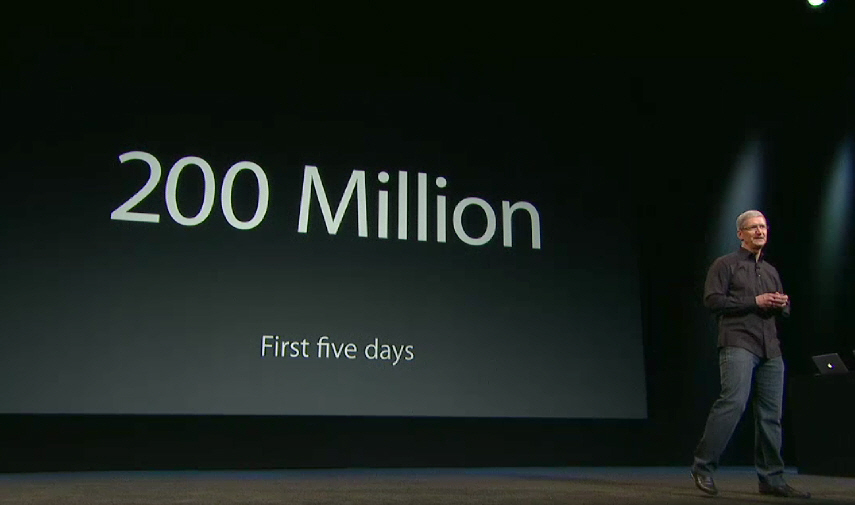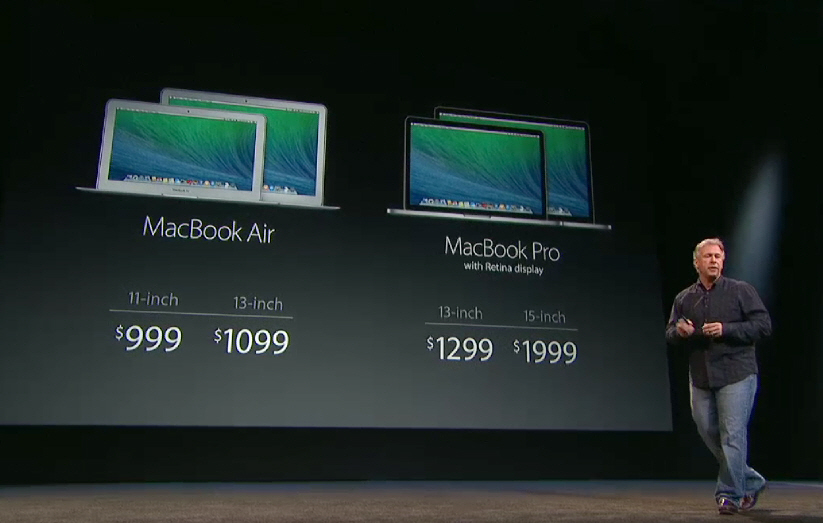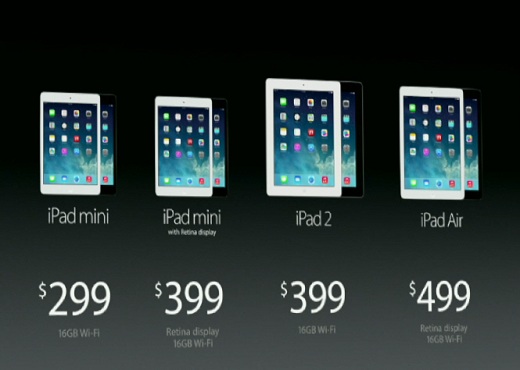Amidst all the leaks and leak-based speculation that has gone on for the last four months, there really was not a whole lot that Apple announced at its event on Tuesday that we didn't already know about and anticipate. Our own most direct interest is in the iPads, but Apple certainly delivered on a number of worthwhile things. Further, as much as we all like to prognosticate and toss out guesses on such things as Apple wearable technology, we certainly were not anticipating any sneak announcements on this front.
We will say though that we were probably not the only ones keeping a close eye on Apple CEO Tim Cook as he wound down the event. But no, there would be no last minute "By the way, one last thing…" from Cook. Maybe someday he will pull it off, but this event wasn't it.
The day began as most of these do, with the usual Cook encomiums to Apple, among them:
- 200 million updated devices to iOS 7 in the first five days;
- 64 percent of Apple mobile devices are now running iOS 7;
- 20 million iTunes Radio listeners have joined up for the service to date;
- Over 1 million apps are now on app store - with 60+ billion downloads and $13 billion in developer revenue generated.

Cook also took a moment to take a swipe at some of Apple's competitors and made fun of their attempts to try and turn PCs into tablets and tablets into PCs. Cook noted that Apple's competitors are all over the map, unlike Apple - which has a simple and clean direction.
Cook then brought senior vice president of software engineering, Craig Federighi, to the stage to take us briefly through OS X Mavericks. He noted the myriad new internal OS improvements, significant memory management improvements, compressed memory capability (e.g. optimizations such as the ability to squeeze 6 GB of data into 4 GB of RAM), and numerous user improvements. He followed up with the requisite Mavericks demo, but we will beg off providing any detail or highlight here - we've heard it all already dating back to Apple's World Wide Developers Conference held earlier this past summer.
Here is the new twist however - and it is quite a twist as the theme then progressed throughout Apple's overall software discussions at the event: the Mavericks release and update is now free to any and all Apple users who have the requisite hardware to run it. This is quite interesting as there is Apple hardware still extant dating back to 2007 that can indeed run Mavericks. The simple idea is to get as much hardware running on one single version of Mavericks as possible, similar to moving as many people as possible onto the very latest version of iOS 7 (which is, by the way, now officially up to v7.03 as of this afternoon).
The MacBooks
Federighi then turned to stage over to Phil Schiller, senior vice president worldwide marketing and sales, to cover Apple's Macbook lineup. Schiller recapped a few things we already know, such as the MacBook Air being able to go an entire day on a single battery charge. The primary focus however was on the MacBook Pro 13 and 15 inch hardware - both of which of course will come with Mavericks.
Apple had already introduced the retina display on its 13 inch MacBook Pro and yesterday followed it up with the announcement that the 15 inch model is also now so endowed. Both machines sport the latest in Intel hardware technology - the 13 inch model is powered by Intel's new Haswell dual core chip and Intel Iris Graphics, while the 15 inch model is powered by an Intel Crystalwell quad core processor and integrated Intel Iris Pro Graphics (models with discrete NVidia GeForce Graphics capability will also be available).
The Haswell and Crystalwell processors and Iris graphics deliver significant power savings. Because of this the MacBook Pro 13" now delivers up to 9 hours of battery time - Schiller notes that he can now watch the entire you can watch entire Batman Dark Knight Trilogy on a single charge. The larger MacBook Pro 15" delivers up to 8 hours per battery charge. These are substantial battery performance numbers - especially when considering the overhead of powering all the pixels in the retina displays of each machine. The starting prices are shown below, and we believe those are quite reasonable for the computing resources being delivered. Both MacBook Pros began shipping on Tuesday.

The Mac Pro - An Awesome Cylindrical Machine
Schiller next went on to highlight the Mac Pro, with its newly engineered cylindrical form factor. Apple provided a preview of the Mac Pro back at its World Wide Developers Conference this summer, and we were quite blown away by it. On Tuesday Apple provided extensive details on it. We've provided the details in the slide show that immediately follows below.


Page 1 of 9
Apple SVP of worldwide marketing Phil Schiller announces the availability of the Mac Pro - December 2013. The Mac Pro is Apple's statement of next generation "desktop" technology.
Page 2 of 9
The new Mac Pro comes with the most advanced Intel processor available.
Page 3 of 9
Internal memory is blazingly fast.
Page 4 of 9
Graphics processing capability is enormously powerful.
Page 5 of 9
Next generation Flash memory enhances internal speeds.
Page 6 of 9
The Mac Pro provides significantly enhanced video capabilities, including support for up to three 4K monitors. Clearly the Mac Pro is built for both serious work and serious gaming.
Page 7 of 9
Extensive connectivity to the outside world is provided; note the Motion Sensor.
Page 8 of 9
Dean Devlin, filmmaker - Independence Day, The Patriot, Leverage - puts the Mac Pro to use to edit 4K work. Note the "tiny" Mac Pro on the right - it takes up one eighth of the total volume of Apple's previous version.
Page 9 of 9
We believe the $2,999 price for the model shown is phenomenal. And get Apple's iLife and iWork apps for free!
All of the truly amazing horsepower delivered by the most modest version of the Mac Pro comes with a starting price of only $2,999 - which we believe represents quite a substantial value. The Mac Pro will become available in early December 2013. It is well worth noting that the Mac Pro is assembled in the United States. Apple provided a video of the production process - which in itself is quite a feat of technology. We did not spot the video on the Apple website but should it make an appearance there it is well worth watching.
Hey - the Software is Suddenly all Free!
Schiller then handed the ball to veteran Apple exec Eddie Cue, senior vice president of Internet software and services (and head of iTunes and pretty much everything else having to do with Apple's collections of cool apps), who walked us through the various key collections of software - in particular iLife (iPhoto, iMovie, GarageBand) for iOS and Mac, and IWork (which is quickly evolving into a real challenger to Microsoft Office). These are all now 64-bit enabled apps that will take full advantage of what the A7 processor has to offer. We don't have the space to elaborate on any of them here unfortunately.
One very cool thing worth noting is that Apple's Mac-based Photo Book service - where users create photo album layouts, send the layouts and image files to Apple and Apple then has an actual bound coffee table book created - is now coming to the iPad. This is a very welcome new iPad capability.
Demos of several new GarageBand capabilities and of iWork/iCloud - including new collaboration in real time capabilities for iWork through iCloud - followed. We will not detail either here.
Here is the day's kicker - iLife and iWork Apps will all be available for free, with Cue noting of course that Office 365 costs $99 per year. All of this software is available as of Tuesday for both iOS and Mavericks with the purchase of new hardware. Users can also download some core free versions of each available app (e.g. GarageBand), which can be enhanced to full capability with an in-app purchase if desired (the old $4.99 price in the case of GarageBand).
With that last bit of news Cue turned things back over to Cook, who noted that it is Apple's goal to simply take software out of the equation from its end. Cook wants everyone - the consumer, educators, enterprises and SMBs - to be able to experience what Apple's hardware delivers. It's certainly a bold and interesting move (though its one we're not really sure Steve Jobs would have approved of, truth be told).
Finally, Time for iPad
Cook next went through the usual numbers presentations of course. He noted that 170 million iPads have been sold since the launch in 2010and 475,000 iPad apps now exist in the App Store. One remarkable note that Cook highlighted is though many other tablets have emerged since the iPad's introduction, the bottom line is that iPad still gets the huge majority of real usage - 81 percent. This certainly also reflects the fact that iOS devices steadfastly account for the majority of all wireless Internet and Web traffic.
Following the litany of stats, Cook brought Phil Schiller - who always gets to do the major hardware announcements, back on stage to reveal the new iPad and iPad Mini. We confess that we were not in the least disappointed. No, there was no astonishingly different "curved" screen iPad. Heck, there wasn't even a fingerprint scanner to be seen anywhere - but it didn't matter.
Schiller first introduced the…iPad Air, which models the MacBook Air relative to thinness and overall lightness of being. The iPad Air completely replaces the 4th Gen iPad, but as expected, sports the same $499 price ($629 with LTE) for the base 16 GB model. The original iPad 2 remains in the lineup for $399.
Dare we ask why there is an antiquated iPad 2 still in the lineup? Because the entire world does not need a retina quality display or the power of the new iPad Air. Many if not all enterprises or school environments do not need their employees or students to ogle with wonder at retina displays or require the computing resources. A much cheaper yet still pretty damn good looking iPad 2 will certainly suffice.
For those among us who dare to ogle, we've put together a second slideshow in a separate article to provide the iPad Air details.
The iPad Air delivers the same 9.7 inch retina display as all previous iPads, but does so with a new bezel design that is 43 percent thinner than previous models. This makes the iPad Air substantially narrower than its siblings. It is also now 20 percent thinner, at a mere 7.5mm thick (or rather 7.5mm thin) than the iPad 4. Most impressive, the iPad Air weighs only one pound - a substantial drop from the iPad 4's 1.4 pounds.
The iPad Air comes with the same 64-bit A7 chip and M7 motion co-processor found in the iPhone 5s. It is perhaps notable that the new iPad did not come with the A7X - which some among us had speculated was a possibility. The graphics capabilities are also greatly improved. The iPad Air will typically deliver 2X faster performance across the board than the iPad 4, and while only 8X faster than the original iPad it delivers huge 72X better graphics performance over the original iPad.
With the graphics and processor improvements comes much better power management and lower power consumption. This allowed Apple to use a thinner battery while still maintaining the same 10 hour battery life. The thinner battery was critical to reducing both thinness and weight.
Finally, Apple has also provided expanded LTE support, following in the footsteps of the iPhone 5s, and now utilizes MIMO (multiple in, multiple out) Wi-Fi with dual antennas for significantly speedier 2X wireless access improvement.
The iPad Air will ship in silver, white, space gray and black beginning on November 1, 2013. A substantial number of countries - including for the first time China- will be part of the first wave of shipments.
Finally, Schiller introduced the new iPad Mini with Retina Display. Available beginning in "later November 2013," the new iPad Mini delivers the same exact pixel count - 2048 x 1536 as the iPad Air. Since the Mini display is only 7.9 inches it will in fact pack a higher pixel per inch count than the iPad Air.
The Retina Mini delivers the same A7 chip and M7 motion co-processor, along with significant performance gains - 4X better processing and 8X graphics improvements over the original Mini. Battery life, despite the additional retina display power requirements, remains at 10 hours.
Also available in silver, white, space gray and black, the new Mini will sell for $399 ($529 with LTE) for the base 16 GB model. The original iPad mini remains in the lineup with a price drop to $299.
Some Comments
The addition of the retina display capability to the iPad Mini may seem nothing more than an incremental improvement to the device. But in fact it is a substantial improvement when taken together with the addition of the A7 64-bit architecture. It has been totally redesigned, and maintaining the battery life while adding significant power requirements through the retina display counts as an achievement.
The iPad Air, we believe, is a true innovation. A one pound device in a near 10 inch display form factor leaves us with no choice but to head back to the Apple store yet again. As with the Retina Mini the internals have been totally redesigned and the ability to deliver so much additional power by way of a smaller and lighter battery is a feat well worth noting. Here is the new lineup, along with relevant base pricing.

Is there an A7X processor lurking in the background? We believe so. Is there a fingerprint scanner lurking in the background? Definitely. It leads us to think we may see yet another iPad coming our way sooner than later. Perhaps it may make an appearance as the iPad Pro - a device that might more specifically target professional and enterprise users with capabilities consumers simply do not need. Certainly the name change to parallel the MacBook Air leaves the possibility open to parallel the MacBook Pro with an iPad Pro. Why not?
We do note that the iPad Mini with Retina Display won't ship until later November. Does this mean supplies will be constrained to the point that it will be hard to find during the holiday season? That is a great question that we are sure analysts will ask when Apple holds its Q3 2013 earnings call at the end of next week. We'll know then.
For us, the Mac Pro and the iPad Air represent true innovation and achievement for 2013. We reiterate as well that we believe Apple is now extremely well-positioned for the holiday season.
As we've noted often enough to date, we are really looking forward to that Apple Q1 2014 post-holiday season earnings call.
Edited by
Stefania Viscusi